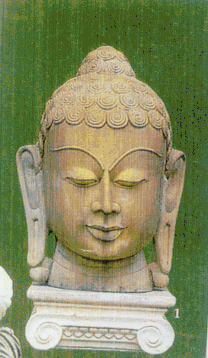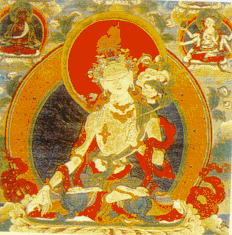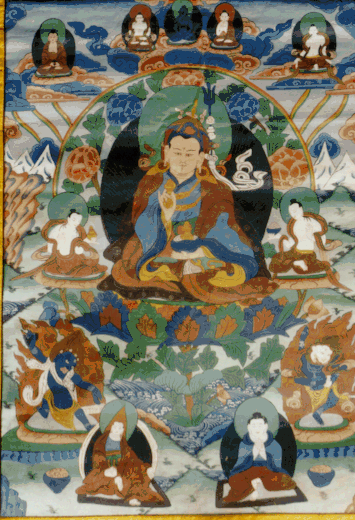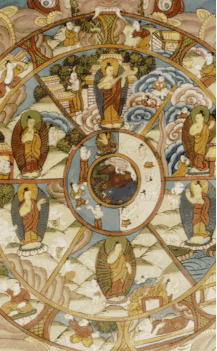THE THANKAS
OF TIBET
BY
PADMA
KRISHNAMURTHY
 Om Mani Padme Hum
The
Thanka is a work of
religious art from Tibet, similar
in form to the Chinese
scroll paintings. Thankas are painted
on cloth, stiffened with
glue, and use natural colours
derived from stones, leaves
and flowers, dipped in egg
yolk like tempera paintings. They
are generally painted by Buddhist
novitiates in the monasteries
with themes drawn from the
buddhist religious tradition. They
are intended to serve as
an aid for meditation in
religious and spiritual
Om Mani Padme Hum
The
Thanka is a work of
religious art from Tibet, similar
in form to the Chinese
scroll paintings. Thankas are painted
on cloth, stiffened with
glue, and use natural colours
derived from stones, leaves
and flowers, dipped in egg
yolk like tempera paintings. They
are generally painted by Buddhist
novitiates in the monasteries
with themes drawn from the
buddhist religious tradition. They
are intended to serve as
an aid for meditation in
religious and spiritual
practices. They
serve as a mobile shrine
for the simple nomadic Tibetan
people, ever on the move
in search of work, food
and trade.
Buddhism
originated in India, with
Buddha the founder, having been
born in Lumbini, brought
up in Magadha and attained Nirvana
in Sanchi. Its deep humanism,
respect for all forms of
life and social harmony,
concern for suffering and commitment
to ethical living, found
such wide appeal that it
soon spread far and wide
both within India and outside,
extending to Tibet and
China in the
North, Sri
Lanka in the South and
Burma, Thailand etc in the
East.
Yet,
though Buddhism arose essentially
as a reaction to some of the
beliefs and practices of
Hinduism, much of it's religious,
spiritual and mystic appeal and
symbolism came from it's Hindu
roots, and much of these
influences are readily recognizable
in
the Buddhist
context.One can recognize Siva
with his trident in
the Bodhisattva
Ratnasambhava, Parvati in the compassionate
mother Tara, Saraswati, the
goddess of knowledge and music,
in Mandanrava, Lakshmi the goddess
of wealth, in Manjusri
and
of course,
Yama, the Lord of life
and death in the ubiquitous
Mara.
The
Thankas depicted these gods
and goddesses as seen in
illustrations (A) and (B.
A more basic theme is the
Kala Chakra Mandala seen in
illustration (C). It shows a
four-petalled lotus at the centre,
standing for the spiritual unfolding
of the heart; a
conch representing
the resonances of the mantric
sound; and
knotted materials
representing the binding knots
of human existence. The main
image is the Kala Chakra
Mandala, the Wheel of Time,
with ten
pictorial themes along it's circumference
: a blind woman groping
with a stick, standing for
spiritual blindness; the potter
making pots, standing for men
reaping the results of
their actions;
the monkey
leaping from branch to
branch, standing for the restless mind
jumping from thought to
thought; the boatman representing the
consciousnes that ferries one across
the sea of life to
the other shore; a house
with six windows standing for
the six senses; symbols
standing for the sense of
touch and taste; a pair
of lovers
standing for
the bonds of attachment;
and last but not least,
a funeral procession to
remind one of the ever-present
Death.
It is
noteworthy, perhaps even surprising,
that in a land with little
or no greenery, and the
landscape is stark and gaunt,
there should be such vibrant
colours in this art form
of Tibet. The people of
this land seem to have
few needs beyond the prayer
wheel and the chant of
the Maha Mantra, "Om Mani Padme Hum", which
seem to bring them peace
and contentment. The Kala
Chakra Mandala Thanka seems
designed to constantly remind
them that in life, this
is all that really matters.
RETURN TO INDEX OF PRESENTATIONS ON
THE ARTS


 (A)
(A)
 (B)
(B)
 (C)
(C)